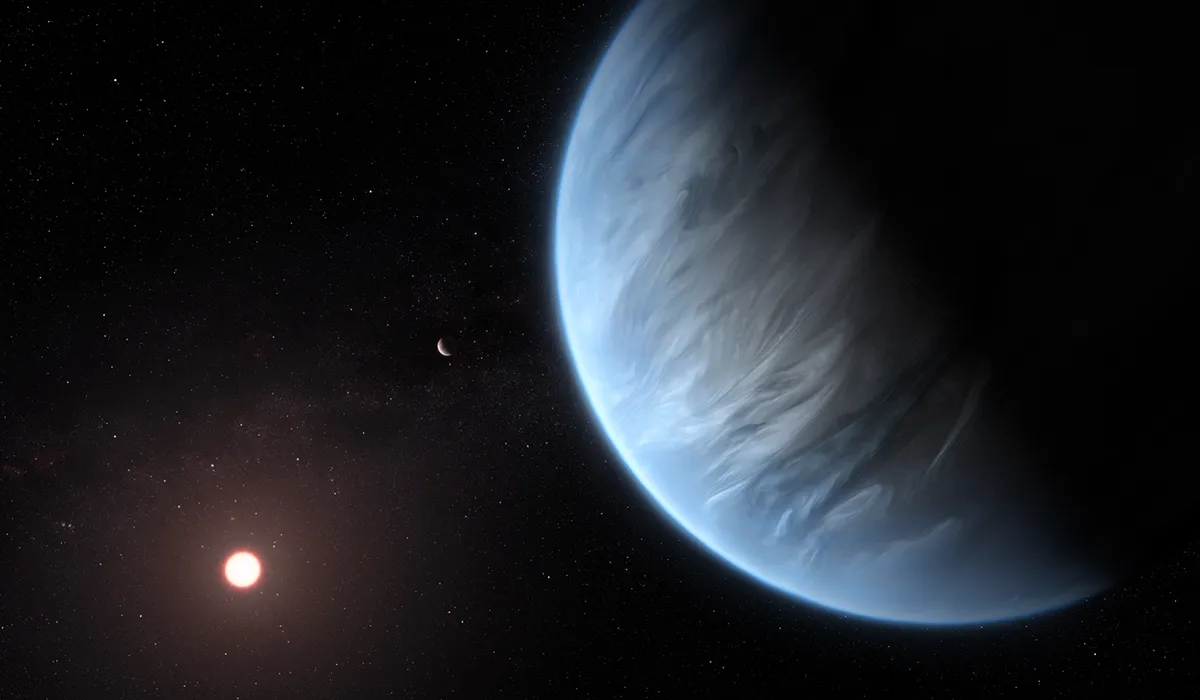The Fermi Paradox is one of the most famous conundrums pertaining to the search for intelligent, extra-terrestrial life. Unsurprisingly, it is one of many subjects explored by author Wade Roush in his new book Extraterrestrials, from MIT Press, which takes a scientific look at the question of whether alien life might exist elsewhere in the Universe.
Below is an extract taken from the book, which looks at the origins and implications of what at first sight appears to be a very simple cosmological question: 'will we ever find life beyond Earth?'

It’s the summer of 1950. In Los Alamos, New Mexico—site of the development of the first atomic bomb—a clutch of prominent nuclear physicists, including Hans Bethe, Edward Teller, Emil Konopinski, and Enrico Fermi, has reassembled to work on an even more powerful weapon, a hydrogen bomb.
The scientists gather daily for lunch at the Fuller Lodge, the main building of the old boys’ school purchased by the US Army in 1943 to make way for the bomb laboratory.
One day Herbert York, a visitor from the Physics Department at Berkeley, joins a table inside the lodge where Konopinski, Teller, and Fermi are in the middle of a conversation.
Read more about the search for life beyond Earth:
- Could an exoplanet's atmosphere indicate the presence of life?
- SETI project listens in on fast radio bursts
- Does oxygen on an exoplanet indicate an Earth-like world?
Fermi possesses a brilliant and playful mind, and he enjoys posing semi-rhetorical questions that can be answered through rough estimation and back-of-the-envelope calculations.
It’s such a habit with him that his brain teasers—such as “How many piano tuners are there in Chicago?”—would come to be known as Fermi Problems or Fermi Questions. (The answer to the Chicago puzzler is a few hundred.)
On this particular day, the topic is not pianos, but flying saucers.
Starting in 1947, there had been a series of highly publicized sightings of these unidentified objects.
Press coverage had generated enough lighthearted buzz to inspire a cartoon in the New Yorker, showing aliens returning to their home planet toting trash cans stolen from the New York Department of Sanitation. (The cartoon was a tongue-in- cheek solution for two mysteries at once: UFOs and a rash of missing trash cans in New York.)
Earlier in the day Konopinski had noticed this cartoon and mentioned it to Fermi, sparking the conversation.
Just as York sits down, Fermi bursts out: “Don’t you ever wonder where everybody is?”

Everyone at the table understands that Fermi is talking about extraterrestrials. It’s easy enough for the scientists to laugh off the popular idea that flying saucers are spaceships from other star systems, piloted by actual aliens.
But that begs a larger question: If flying saucers aren’t real and nobody has traveled through interstellar space to visit us, why not?
Fermi does some quick math, estimating quantities such as the age and size of the Milky Way, the number of stars and planets it contains, and the odds of intelligent life evolving on each planet.
His calculation shows that our galaxy ought to be rife with civilizations.
If no one has visited us, Fermi concludes, it’s probably not because they don’t exist; it’s more likely that Einstein’s universal speed limit—the speed of light, 3 × 108 meters/second—makes interstellar travel difficult or impossible.
The lunch companions nod and agree that the question is a deep and important one. But on this day they fail to resolve it.
After lunch, they go back to designing their bomb.
The Power of Paradox
The point of these two stories—one a fable, the other true—is that we don’t know what we don’t know.
For thousands of years, the Native people of the Americas were safe in their isolation.
It would have been natural to dismiss worries about rapacious, slave-driving, disease-carrying invaders—right up to the moment Columbus arrived.
Even today, there’s no way to disprove Fermi’s conclusion that we on Earth are safe in our isolation.
He may have been right that the vast distances between the stars will keep us from ever meeting extraterrestrials.
We should not be alone, yet apparently we are. How is that possible? This question has fuelled decades of debate and speculation.
But Fermi was thinking only about physical contact. His conclusion would become moot if we were to detect an electromagnetic signal of intelligent extraterrestrial origin or notice some obvious sign of engineering elsewhere in the galaxy.
Over the years, Fermi’s question “Where is everybody?” has ripened into a larger intellectual conundrum that students of SETI call the Fermi Paradox.
The problem isn’t really about the speed of light or whether the hypothetical aliens are too lazy or short-lived to visit us.
It can be framed this way: everything we know about how planets form and how life arises suggests that human civilisation on Earth should not be unique.
In fact, our galaxy is old enough to have been thoroughly colonised, perhaps several times over. So we ought to see abundant evidence of extraterrestrial activity.
But we don’t see anything, not even radio blips and certainly not derelict spaceships or the monuments of dead civilisations.
We should not be alone—yet apparently we are. How is that possible? This question has fuelled decades of debate, speculation, and, lately, some actual science.

“It is hard to conceive a scientific problem more pregnant and richer in meaning and connection with the other ‘Grand Questions’ of science throughout the ages,” writes Milan Ćirković in The Great Silence, a masterful new book showing how deep the problem really goes.
Part of what makes the problem so deep is that it is in fact a formal paradox. The word paradox comes from the Greek term paradoxon, “contradictory opinion.”
It usually means “a proposition that proceeds from seemingly sound premises to a senseless or illogical conclusion.”
Paradoxes can be seen as useful irritants. They beg for resolution.
The key phrase in the definition is “seemingly sound premises.” When a paradox pops up, it’s often an indication that the premises are not as sound as supposed or that there’s something wrong in the chain of reasoning.
So what’s the truth hiding behind the Fermi Paradox? Which flawed assumption would have to be excised to resolve it? What are we missing?
One possibility is that life, especially intelligent life, is less common than Fermi originally calculated.
That’s the idea favoured by Peter Ward and Donald Brownlee, authors of Rare Earth: Why Complex Life Is Uncommon in the Universe. We may find microbial life on many planets, Ward and Brownlee concede.
But advanced, multicellular life can emerge, they propose, only when a planet enjoys an unusual combination of advantages, such as a Jupiter-size neighbour (to clear the neighbourhood of debris), a large moon, plate tectonics, and a magnetic field.
Another possibility is that intelligent extraterrestrials do exist, but we just haven’t met them yet.

This is the answer offered by Carl Sagan in Contact, both the novel and the movie.
In Sagan’s fictional treatment, TV signals from Earth reach an alien detector near the star Vega, 25 light years away.
This prompts an elaborate coded response that includes the blueprints for a kind of stargate; most of the suspense in the movie version is about who will get to go through it.
The story amounts to an argument that we are not alone and that signs of intelligent life may lie just outside our grasp.
We should keep looking for them because if we succeed, what we discover could change everything.
That’s the solution to the Fermi Paradox that most SETI proponents still embrace today.
But there are many, many other possible answers.
In fact, one extremely useful book in this field is entitled If the Universe is Teeming with Aliens ... Where Is Everybody?Seventy-Five Solutions to the Fermi Paradox and the Problem of Extraterrestrial Life.
The book you’re holding is meant as a general introduction to the debate over the existence of intelligent extraterrestrials, and in the pages ahead we will encounter many ideas about how the Fermi Paradox may ultimately be resolved.
In chapter 4, I boil the potential solutions down into general categories—fewer than 75, I promise—and review the arguments for and against each.
Ward and Brownlee think that we seem to be alone because we are alone. Others, myself included, feel it’s too early to come to that conclusion.
At this point, we’re still sorting out what former US Secretary of Defense Donald Rumsfeld, in a very different context, called the “known knowns,” the “known unknowns,” and the “unknown unknowns.”

The entire field of astrobiology, for example, is dedicated to determining how life might arise in non-Earth-like environments.
When the discipline was born several decades ago, scientists had little sense of the range of environments in which life might flourish, even here on Earth, let alone elsewhere in our solar system or elsewhere in the galaxy.
But over the past 40 years, the field has advanced in fundamental ways.
For one thing, we have discovered many types of “extremophiles,” organisms thriving around undersea thermal vents and other places so inhospitable that no one would have expected to find life there, right up to the moment they did.
On top of that, astronomers keep adding to the catalog of extrasolar planets, or exoplanets.
As of this writing, there are 4,025 of them. So far none are precisely Earth-like, but many do seem to orbit within the habitable zones of their star systems (for more on this, read our guide What makes an exoplanet habitable?)
The point is that the more extremophiles and exoplanets we discover, the more room there is for exploration by astronomers and astrobiologists and the more unknown unknowns become known unknowns.
With hard work, funding, and a little luck, we might even be able to convert some of them into known knowns. Watching this process fills me with wonder and hope.
Extraterrestrials is available via MIT Press. This extract used with permission.